- ι
- ι
- ι
- ι
- ι
- ι
- Visitor Information
- ι
Thirty Fruit Tree Varieties
Apples
Transparente de Croncels
Raised in 1869 in Croncels, France, this cultivar yields excellent large apples which were once grown and sold all over Europe, but because they bruise easily have disappeared from commercial fruit farming. The apples are juicy with a well-balanced aroma combining sweetness and acidity.
Raised in 1869 in Croncels, France, this cultivar yields excellent large apples which were once grown and sold all over Europe, but because they bruise easily have disappeared from commercial fruit farming. The apples are juicy with a well-balanced aroma combining sweetness and acidity.
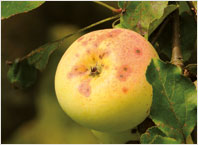
Berlepsch
The full name of this cultivar, according to the British National Fruit Collection, is Freiherr von Berlepsch. It was raised around 1880 in Grevenbroich in the Rhineland and produces superbly aromatic dessert apples. Its fruit are high in Vitamin C and low in allergens. The only disadvantage is the tree's susceptibility to apple canker.
The full name of this cultivar, according to the British National Fruit Collection, is Freiherr von Berlepsch. It was raised around 1880 in Grevenbroich in the Rhineland and produces superbly aromatic dessert apples. Its fruit are high in Vitamin C and low in allergens. The only disadvantage is the tree's susceptibility to apple canker.
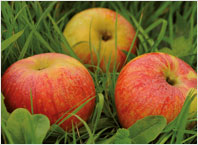
Förster Sauer
Named for its breeder, a forester employed by local landowner Count Nesselrode, this local cultivar originated in Monheim. Although "sauer" means "acid" in German, the fruit are actually quite sweet. This hardy early bearer ripens towards the end of August.
Named for its breeder, a forester employed by local landowner Count Nesselrode, this local cultivar originated in Monheim. Although "sauer" means "acid" in German, the fruit are actually quite sweet. This hardy early bearer ripens towards the end of August.
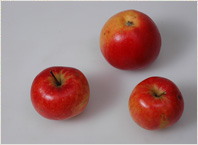
Golden Noble
Discovered in England around 1800, this apple cultivar is resistant to scab and has regularly formed, light green to yellow fruit with a fresh, delicate aroma. Known as Gelber Edelapfel in Germany, it is ready for picking in September and stores well until end of October. Its fruit are low in allergens.
Discovered in England around 1800, this apple cultivar is resistant to scab and has regularly formed, light green to yellow fruit with a fresh, delicate aroma. Known as Gelber Edelapfel in Germany, it is ready for picking in September and stores well until end of October. Its fruit are low in allergens.
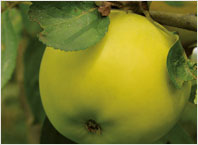
Gravensteiner
This apple cultivar hails from Schleswig-Holstein and was first documented in the eighteenth century. The fruit ripening at the end of August are a colourful yellow with red stripes. They have an exceptional scent and are very juicy with a fine aroma. The delicate trees prefer a warm climate and require some care.
This apple cultivar hails from Schleswig-Holstein and was first documented in the eighteenth century. The fruit ripening at the end of August are a colourful yellow with red stripes. They have an exceptional scent and are very juicy with a fine aroma. The delicate trees prefer a warm climate and require some care.
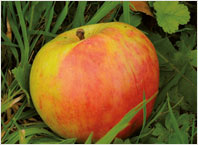
Green Gage or Reine Claude
This green dessert plum was named in France in 1524 in homage to Queen ("Reine") Claudia, daughter of Louis XII. Its fruit are very sweet and aromatic and make excellent jam. Yield varies from year to year.
This green dessert plum was named in France in 1524 in homage to Queen ("Reine") Claudia, daughter of Louis XII. Its fruit are very sweet and aromatic and make excellent jam. Yield varies from year to year.
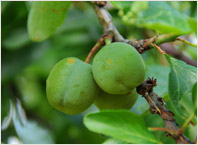
Crab Apple
The crab apple is a wild tree growing in sunny riverine woodlands. Its fruit are small and plain. The cultivated apples we know today are not derived from crab apples, however; their primary ancestor is a wild apple from Kazakhstan.
The crab apple is a wild tree growing in sunny riverine woodlands. Its fruit are small and plain. The cultivated apples we know today are not derived from crab apples, however; their primary ancestor is a wild apple from Kazakhstan.
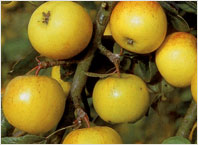
Jacques Lebel
In the Rhineland this apple cultivar is known by a Germanized form of the breeder's name as Jakob Lebel, but it was first raised in France in around 1825. Fresh fruit are pleasantly tasty, very juicy, crisp and have a waxy peel. It is a poor keeper and quickly becomes woolly. The trees are hardy with a high biennial yield. Good for pies, juice, and sauce.
In the Rhineland this apple cultivar is known by a Germanized form of the breeder's name as Jakob Lebel, but it was first raised in France in around 1825. Fresh fruit are pleasantly tasty, very juicy, crisp and have a waxy peel. It is a poor keeper and quickly becomes woolly. The trees are hardy with a high biennial yield. Good for pies, juice, and sauce.
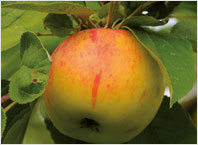
James Grieve
This variety was raised around 1880 near Edinburgh, Scotland, and was named for its breeder. An early bearer, its apples ripen in mid-August and are excellent for eating fresh. They have a pleasant spicy flavour and are very juicy. Like all early apples James Grieve do not store well.
This variety was raised around 1880 near Edinburgh, Scotland, and was named for its breeder. An early bearer, its apples ripen in mid-August and are excellent for eating fresh. They have a pleasant spicy flavour and are very juicy. Like all early apples James Grieve do not store well.
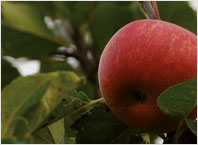
Kaiser Wilhelm
These large, handsome, and tasty apples have a well-balanced aroma combining sweetness and acidity. They ripen in late September or early October. Although the fruit become woolly after three to four weeks in storage, they retain their aristocratic aroma and can still be used for pies or drying.
These large, handsome, and tasty apples have a well-balanced aroma combining sweetness and acidity. They ripen in late September or early October. Although the fruit become woolly after three to four weeks in storage, they retain their aristocratic aroma and can still be used for pies or drying.
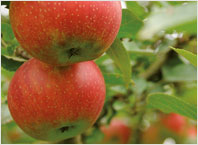
Pinova
Pinova is a modern cultivar raised at the Institute of Fruit Research in Dresden-Pillnitz. Its fruit are very tasty with a well-balanced aroma combining sweetness and acidity. Pinova was introduced commercially in the 1990s. Since it is not resistant to scab, however, it is not suitable for growing in gardens or organic farming.
Pinova is a modern cultivar raised at the Institute of Fruit Research in Dresden-Pillnitz. Its fruit are very tasty with a well-balanced aroma combining sweetness and acidity. Pinova was introduced commercially in the 1990s. Since it is not resistant to scab, however, it is not suitable for growing in gardens or organic farming.
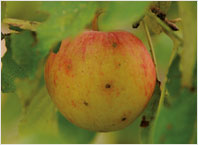
Remo
This apple cultivar was developed by the Institute of Fruit Research in Dresden-Pillnitz and is resistant to most diseases. Its sweet and juicy ruby-red fruit have been sold commercially since 1990. It is a reliable annual bearer and the fruit are good for apple juice and cider. Does not store well.
This apple cultivar was developed by the Institute of Fruit Research in Dresden-Pillnitz and is resistant to most diseases. Its sweet and juicy ruby-red fruit have been sold commercially since 1990. It is a reliable annual bearer and the fruit are good for apple juice and cider. Does not store well.
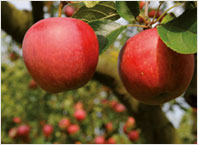
Rheinischer Bohnapfel
Ideal for making apple juice and cider, this cultivar is particularly prevalent in Hesse, where "Äbbelwoi" or apple wine is very popular. The hardy, vigorous tree is a productive bearer. Its high, limited crown makes it suitable for grassed orchards where animals graze.
Ideal for making apple juice and cider, this cultivar is particularly prevalent in Hesse, where "Äbbelwoi" or apple wine is very popular. The hardy, vigorous tree is a productive bearer. Its high, limited crown makes it suitable for grassed orchards where animals graze.
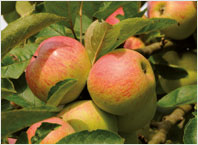
Rheinischer Tulpenapfel
This apple cultivar comes into its own in years with late frost in the main apple flowering season, since it flowers very late and thus avoids frost. The "Rhenish Tulip Apple" is a regional type of apple only to be found in the Rhineland, and only on the river's right bank.
This apple cultivar comes into its own in years with late frost in the main apple flowering season, since it flowers very late and thus avoids frost. The "Rhenish Tulip Apple" is a regional type of apple only to be found in the Rhineland, and only on the river's right bank.
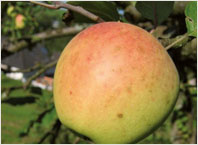
Rheinischer Winterrambur
Also known as Menznauer Jäger, this old, hardy apple cultivar has a spreading crown that makes it unsuitable for small gardens. Its fruit are very tart but mellow with age and keep until April. Excellent choice for pies.
Also known as Menznauer Jäger, this old, hardy apple cultivar has a spreading crown that makes it unsuitable for small gardens. Its fruit are very tart but mellow with age and keep until April. Excellent choice for pies.
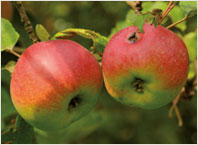
Roter Eiserapfel
Eine der ältesten Obstsorten, die schon im 16. Jahrhundert nachgewiesen ist. Intensiv dunkel gerötete, teilweise lilafarbene Schale. Geschmack süßlich, wenig Säure, wenig gewürzt. Anbau früher vor allem wegen seiner sehr langen Lagerfähigkeit bis in den Mai.
Eine der ältesten Obstsorten, die schon im 16. Jahrhundert nachgewiesen ist. Intensiv dunkel gerötete, teilweise lilafarbene Schale. Geschmack süßlich, wenig Säure, wenig gewürzt. Anbau früher vor allem wegen seiner sehr langen Lagerfähigkeit bis in den Mai.
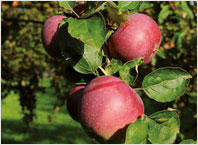
Reinette Rouge Etoile
The apple cultivar known as Rote Sternrenette in Germany can be traced back nearly two hundred years and is thought to have originated in the Lower Rhine area. Its ripe fruit are bright red with tiny light-coloured dots and have fine-textured, juicy flesh with weak aroma. Yields vary from year to year (biennial bearing).
The apple cultivar known as Rote Sternrenette in Germany can be traced back nearly two hundred years and is thought to have originated in the Lower Rhine area. Its ripe fruit are bright red with tiny light-coloured dots and have fine-textured, juicy flesh with weak aroma. Yields vary from year to year (biennial bearing).
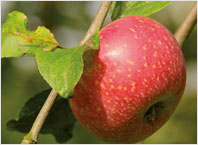
White Transparent
These apples ripen at the end of July before any other apples are ready for picking. They are juicy, sweet, and soft. Since the fruit cannot be stored for more than two weeks, they are mostly used for making apple sauce. As good pollinators White Transparents are important for many other cultivars.
These apples ripen at the end of July before any other apples are ready for picking. They are juicy, sweet, and soft. Since the fruit cannot be stored for more than two weeks, they are mostly used for making apple sauce. As good pollinators White Transparents are important for many other cultivars.
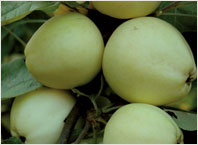
Winter Banana
First cultivated in Ohio, USA, around 1860, winter bananas have large, juicy, mildly acidic apples that are good for eating and store well. The name derives from their faint banana flavour. Since it requires mild climates it is well suited to the Rhineland.
First cultivated in Ohio, USA, around 1860, winter bananas have large, juicy, mildly acidic apples that are good for eating and store well. The name derives from their faint banana flavour. Since it requires mild climates it is well suited to the Rhineland.
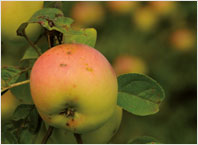
Winterglockenapfel
This small, bell-shaped apple blushing redly on the sunny side has white, firm flesh and a pleasant, refreshing acidity. Fruit ripen towards the end of October and keep for several months. This cultivar is not suitable for cool upland climates.
This small, bell-shaped apple blushing redly on the sunny side has white, firm flesh and a pleasant, refreshing acidity. Fruit ripen towards the end of October and keep for several months. This cultivar is not suitable for cool upland climates.
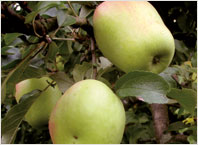
Golden Winter Pearmain
Also known as King of the Pippins, the Golden Winter Pearmain can be traced back to the Middle Ages and probably originated in France, where it is identical to the Reine des Reinettes.Its fruit are sweet, honeyed, with a spicy aroma. The crown of the tree requires regular pruning since its fruit tend to taste bland when shaded. The tree is susceptible to apple canker.
Also known as King of the Pippins, the Golden Winter Pearmain can be traced back to the Middle Ages and probably originated in France, where it is identical to the Reine des Reinettes.Its fruit are sweet, honeyed, with a spicy aroma. The crown of the tree requires regular pruning since its fruit tend to taste bland when shaded. The tree is susceptible to apple canker.
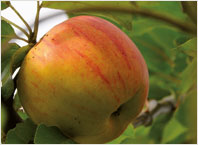
Winter Lemon
The fruit of this apple cultivar are bright yellow with a red blush on the sunny side. The flavour is crisp with a fine, spicy aroma. It is good for eating and for making apple juice or cider, stores well for several months and has good resistance to scab and bitter pit.
The fruit of this apple cultivar are bright yellow with a red blush on the sunny side. The flavour is crisp with a fine, spicy aroma. It is good for eating and for making apple juice or cider, stores well for several months and has good resistance to scab and bitter pit.
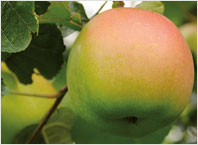
Zuccalmaglios Renette
Developed by Diedrich Uhlhorn Jr. of Grevenbroich, this apple cultivar is a productive bearer of small, juicy fruit with a fine aroma. It is good for cooking or eating and stores well for several months. The fruit do not drop in strong wind and are resistant to most diseases. As young shoots tend to be thin, the tree requires intensive pruning.
Developed by Diedrich Uhlhorn Jr. of Grevenbroich, this apple cultivar is a productive bearer of small, juicy fruit with a fine aroma. It is good for cooking or eating and stores well for several months. The fruit do not drop in strong wind and are resistant to most diseases. As young shoots tend to be thin, the tree requires intensive pruning.
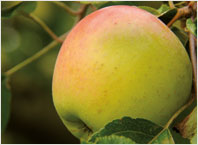
Plums
Bühler Frühzwetschge
Discovered in 1894 near Bühl in Baden, this plum cultivar yields blue fruit that are ready for picking from the beginning of August, around two weeks earlier than the common plum. Its fruit are juicy, ideal for making preserves, and resistant to most diseases and pests.
Discovered in 1894 near Bühl in Baden, this plum cultivar yields blue fruit that are ready for picking from the beginning of August, around two weeks earlier than the common plum. Its fruit are juicy, ideal for making preserves, and resistant to most diseases and pests.
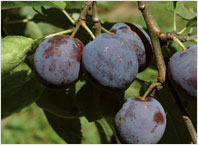
Common Plum or Zwetschge
This subspecies of the plum hails from Central Asia and has been cultivated in Germany since the Roman age. It is the first choice for fruit tarts. The plums ripen late in August. The tree is generally very hardy, the main danger being plum pox or sharka, a virus that causes misshapen and blemished fruit. The Rhineland is currently free of the sharka virus.
This subspecies of the plum hails from Central Asia and has been cultivated in Germany since the Roman age. It is the first choice for fruit tarts. The plums ripen late in August. The tree is generally very hardy, the main danger being plum pox or sharka, a virus that causes misshapen and blemished fruit. The Rhineland is currently free of the sharka virus.
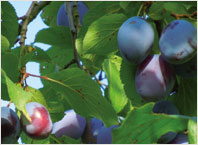
Pears
Pear "Beurré Hardy"
Renamed Gellerts Butterbirne when introduced in Germany, this type was first discovered in France in 1838. A superb dessert pear, it has a harmonious flavour combining sweetness with acidity, a melting texture, and juicy flesh. Well cared for it is one of the best autumn-bearing pears. As its standard variety does not yield fruit until ten to twelve years old, it has become rare in cultivation.
Renamed Gellerts Butterbirne when introduced in Germany, this type was first discovered in France in 1838. A superb dessert pear, it has a harmonious flavour combining sweetness with acidity, a melting texture, and juicy flesh. Well cared for it is one of the best autumn-bearing pears. As its standard variety does not yield fruit until ten to twelve years old, it has become rare in cultivation.
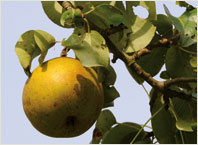
Pear "Grähling"
This rare old cultivar is exclusive to the Rhineland and only found on the river's right bank. Its healthy, vigorous trees grow to an impressive height. Fruit are spicy and sweet when eaten straight from the tree but quickly become woolly when stored. They are good for roasting, drying, and pear butter.
This rare old cultivar is exclusive to the Rhineland and only found on the river's right bank. Its healthy, vigorous trees grow to an impressive height. Fruit are spicy and sweet when eaten straight from the tree but quickly become woolly when stored. They are good for roasting, drying, and pear butter.
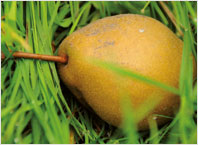
Pear "Charneux"
This variety was discovered in Belgium around 1800 by Martin Légipont. To this day it is an important commercial fruit and is widely cultivated in fruit plantations. Its juicy pears have tasty, melt-in-the-mouth flesh combining a fine spicy flavour with intense sweetness. Regular pruning and good soil care usually guarantee reliable ample yields.
This variety was discovered in Belgium around 1800 by Martin Légipont. To this day it is an important commercial fruit and is widely cultivated in fruit plantations. Its juicy pears have tasty, melt-in-the-mouth flesh combining a fine spicy flavour with intense sweetness. Regular pruning and good soil care usually guarantee reliable ample yields.
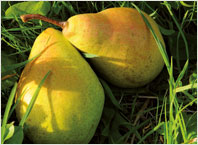
Pear "Doyenné du Comice"
This pear originated in France around 1845. Its fruit do not ripen until the end of October. The pears are yellow with a red blush on the sunny side. The flesh is buttery, juicy, sweet, and tasty. As it is one of the few dessert pears that store well, it is very popular despite moderate crops.
This pear originated in France around 1845. Its fruit do not ripen until the end of October. The pears are yellow with a red blush on the sunny side. The flesh is buttery, juicy, sweet, and tasty. As it is one of the few dessert pears that store well, it is very popular despite moderate crops.
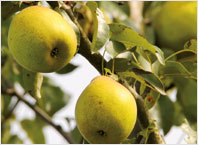
Cherries
Cherry "Büttner's Rote Knorpel"
Raised from seedlings in Halle by Carl Gottlieb Büttner around 1795, this variety bears firm, tasty, blushed yellow fruit that ripen in June. The trees grow to an impressive height and yield regular, reliable crops.
Raised from seedlings in Halle by Carl Gottlieb Büttner around 1795, this variety bears firm, tasty, blushed yellow fruit that ripen in June. The trees grow to an impressive height and yield regular, reliable crops.
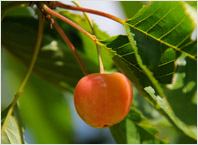
Cherry "Grosse Schwarze Knorpel"
This cultivar was first documented in France in 1540 as "Cerise Coeur Noir", or black-hearted cherry. Its fruit are indeed a dark purple, sweet and spicy. It is good for eating fresh and for making preserves.
This cultivar was first documented in France in 1540 as "Cerise Coeur Noir", or black-hearted cherry. Its fruit are indeed a dark purple, sweet and spicy. It is good for eating fresh and for making preserves.
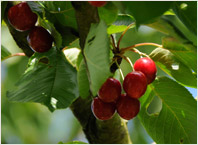
Search:






